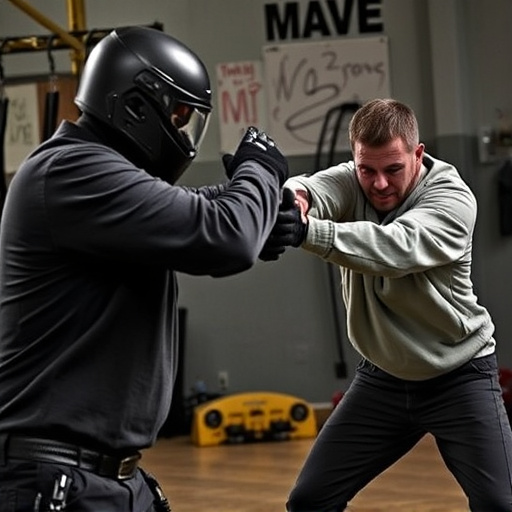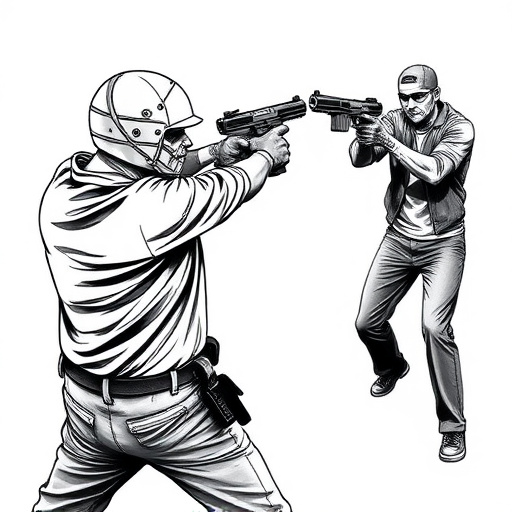Optimal stun gun electrode spacing (1.5 inches or less) enhances effectiveness and safety for self-defense, particularly in concealed carry models like Taser Pulse 2 and Guard Dog Stun Gun. Close contact (1-2 inches) is required for activation, ensuring powerful jolts to vital areas while minimizing current leakage. Advanced electrode designs in top concealed carry stun guns disrupt muscular control, enhancing tactical effectiveness during close-quarters combat.
In today’s world, self-defense is a serious concern. Stun guns have emerged as powerful tools, but understanding electrode spacing is crucial for their effectiveness. This guide delves into the intricate details of stun gun electrode placement, exploring key factors and optimal distances for activation. We analyze the best hidden stun gun models suitable for concealed carry, and provide insights from real-world applications. By the end, you’ll be equipped with knowledge to make informed decisions about self-defense strategies.
- Understanding Stun Gun Electrode Spacing
- Key Factors in Effective Stun Gun Placement
- Best Hidden Stun Guns for Concealed Carry
- Testing Stun Gun Models' Electrodes
- Optimal Distance for Stun Gun Activation
- Real-World Applications of Stun Gun Spacing
Understanding Stun Gun Electrode Spacing

Understanding Stun Gun Electrode Spacing
The effectiveness of a stun gun significantly relies on its electrode spacing, which is the distance between the positive and negative terminals that deliver an electric shock to the target. For self-defense purposes, it’s crucial to consider models with optimal electrode placement, ensuring maximum impact with minimal current leakage. The best concealed carry stun gun models often feature close electrode spacing, typically around 1.5 inches or less, allowing for precise and powerful jolts without being noticeable.
This configuration enables the user to target vital areas of the body, such as the neck, groin, or arms, where even a low-amplitude shock can incapacitate an assailant effectively. Proper electrode spacing also helps in minimizing the risk of accidental shocks, making it safer for both the user and bystanders.
Key Factors in Effective Stun Gun Placement

When considering the effectiveness of a stun gun, one of the crucial factors is the electrode spacing—the distance between the positive and negative electrodes in the device. Proper placement ensures the highest likelihood of successfully immobilizing a target. For concealed carry stun guns, this becomes even more critical, as users need to deploy them quickly and efficiently without drawing too much attention.
Best concealed carry stun gun models typically feature optimized electrode spacing designed for maximum impact with minimal size. This allows users to easily access the device while maintaining discreteness. Factors like electrode arrangement, current output, and pulse width also play significant roles in determining effectiveness. Understanding these key aspects can ensure that a stun gun not only fits comfortably for concealed carrying but also delivers powerful jolts when needed.
Best Hidden Stun Guns for Concealed Carry

When it comes to hidden stun guns for concealed carry, choosing the right model depends on balancing power, size, and discretion. Some of the best concealed carry stun gun models offer a slim design that fits comfortably in pockets or purses, while still delivering a powerful jolt. Look for options with electrode spacing between 1-2 inches to ensure optimal contact area for maximum effectiveness. Models like the Taser Pulse 2 and the Guard Dog Stun Gun are popular choices known for their compact size and robust stun capabilities. These devices provide peace of mind, allowing you to protect yourself discreetly in various situations.
Remember, the key to effective self-defense with a stun gun is ease of access and reliability. The best concealed carry stun guns strike a balance between discretion and power, ensuring you can respond swiftly when needed. Always prioritize safety and familiarize yourself with local laws regarding stun gun ownership and use before carrying one for self-defense.
Testing Stun Gun Models' Electrodes

When evaluating the effectiveness of stun gun models, testing the electrode spacing is a crucial step. The proximity and placement of electrodes directly impact the stun gun’s performance and range. Best concealed carry stun gun models often prioritize compact design without sacrificing electrode quality. Manufacturers conduct rigorous tests to ensure their stun guns deliver a powerful jolt even with minimal electrode space, making them ideal for self-defense in tight situations.
These tests involve simulated scenarios that mimic real-world applications, allowing for a comprehensive understanding of the weapon’s capabilities. By studying how electricity flows through different models’ electrodes, researchers can determine their overall effectiveness. The most successful stun guns strike a balance between compactness and electrode performance, ensuring users have a reliable self-defense tool while maintaining ease of concealment.
Optimal Distance for Stun Gun Activation

The optimal distance for activating a stun gun varies among models, but it’s crucial to understand that close contact is generally required for effective deployment. Best concealed carry stun gun models typically have electrodes spaced between 1-2 inches apart, allowing for direct contact with the target. This intimate range ensures the electrical current flows directly from the stun gun into the intended subject, disrupting their nervous system and causing immobilization.
When considering a stun gun for self-defense, it’s important to look for models designed with precise electrode spacing, as this can significantly impact effectiveness. These best concealed carry stun guns are designed for ease of use in emergency situations, where every second counts. Proper training on the ideal distance and proper usage is essential to ensure safety and maximum efficiency when relying on a stun gun in a high-stress situation.
Real-World Applications of Stun Gun Spacing

In real-world applications, the spacing of electrodes on a stun gun plays a critical role in its effectiveness. When considering the best concealed carry stun gun models, electrode placement and spacing are key factors for optimal performance. Stun guns with well-designed electrode arrangements can deliver more consistent and powerful jolts, ensuring their users have a reliable means of self-defense in various scenarios.
For instance, proper spacing allows for better electrical conductivity, enabling the stun gun to efficiently disrupt an assailant’s muscular control and balance. This is particularly important for tactical situations where quick incapacitation is crucial. Additionally, some stun guns incorporate advanced electrode designs that enhance their effectiveness during close-quarters combat or when targeting specific body areas known to be more sensitive to electrical shocks. Such innovations in electrode spacing contribute to the overall safety and efficacy of stun guns as concealed carry devices.
When it comes to choosing the best concealed carry stun gun models, understanding electrode spacing and optimal placement is key to ensuring effectiveness. By considering factors like body type, stun gun size, and intended use, users can maximize the impact of their stun device. Regular testing and evaluation of different models’ electrodes allow individuals to make informed decisions. In real-world scenarios, proper spacing and activation distance can significantly enhance personal safety, making stun guns a valuable tool for self-defense when used correctly.
